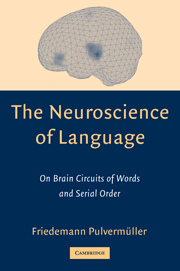Book contents
- Frontmatter
- Contents
- Preface
- The Neuroscience of Language
- 1 A Guide to the Book
- 2 Neuronal Structure and Function
- 3 From Classic Aphasia Research to Modern Neuroimaging
- 4 Words in the Brain
- Excursus E1 Explaining Neuropsychological Double Dissociations
- 5 Regulation, Overlap, and Web Tails
- 6 Neural Algorithms and Neural Networks
- 7 Basic Syntax
- 8 Synfire Chains as the Basis of Serial Order in the Brain
- 9 Sequence Detectors
- 10 Neuronal Grammar
- 11 Neuronal Grammar and Algorithms
- Excursus E2 Basic Bits of Neuronal Grammar
- Excursus E3 A Web Response to a Sentence
- 12 Refining Neuronal Grammar
- Excursus E4 Multiple Reverberation for Resolving Lexical Ambiguity
- Excursus E5 Multiple Reverberations and Multiple Center Embeddings
- 13 Neurophysiology of Syntax
- 14 Linguistics and the Brain
- References
- Abbreviations
- Author Index
- Subject Index
2 - Neuronal Structure and Function
Published online by Cambridge University Press: 15 December 2009
- Frontmatter
- Contents
- Preface
- The Neuroscience of Language
- 1 A Guide to the Book
- 2 Neuronal Structure and Function
- 3 From Classic Aphasia Research to Modern Neuroimaging
- 4 Words in the Brain
- Excursus E1 Explaining Neuropsychological Double Dissociations
- 5 Regulation, Overlap, and Web Tails
- 6 Neural Algorithms and Neural Networks
- 7 Basic Syntax
- 8 Synfire Chains as the Basis of Serial Order in the Brain
- 9 Sequence Detectors
- 10 Neuronal Grammar
- 11 Neuronal Grammar and Algorithms
- Excursus E2 Basic Bits of Neuronal Grammar
- Excursus E3 A Web Response to a Sentence
- 12 Refining Neuronal Grammar
- Excursus E4 Multiple Reverberation for Resolving Lexical Ambiguity
- Excursus E5 Multiple Reverberations and Multiple Center Embeddings
- 13 Neurophysiology of Syntax
- 14 Linguistics and the Brain
- References
- Abbreviations
- Author Index
- Subject Index
Summary
A realistic model of language must specify the mechanisms underlying language use and comprehension. What are the relevant mechanisms? It is certain that it is the human brain that provides the mechanisms realizing language, and it is almost equally certain that language mechanisms are organized as nerve cells and their mutual connections. A realistic model of language, therefore, must specify the putative organic basis of language use and language comprehension in terms of neurons, neuronal connections, and neuron circuits. This does not necessarily mean that the model must specify each and every single neuron that participates, but it does mean that the circuits believed to underlie language function should be specified as far as possible and relevant. Rather than saying that a language sound, word, or syntactic rule is represented in the brain, period, one may wish to learn in which way such sounds, words, or rules are laid down. Therefore, it is necessary to introduce known neuronal mechanisms and others that can be inferred from more recent data.
Chapter 2 gives a brief introduction to neuronal mechanisms, with special emphasis on those mechanisms that may be relevant for organizing language. The chapter first addresses questions about neuronal architecture or structure (Section 2.1). What is a nerve cell or neuron? What is the global structure of the cortex, the portion of the brain most important for language? The idea here is that these anatomic structures are related to the computations in which they are involved.
- Type
- Chapter
- Information
- The Neuroscience of LanguageOn Brain Circuits of Words and Serial Order, pp. 9 - 32Publisher: Cambridge University PressPrint publication year: 2003



